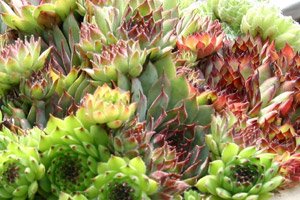
Sempervivums are alpines from North Africa, Europe, and parts of Asia. Their Latin name may be broken down into; semper, meaning forever and vivum, meaning to live. They are very easy to propagate. Given a well drained soil, they will produce attractive, rosette forming plants which are deservedly popular. There is a wide range of hybrids available. Not all forms are hardy, certain varieties may need some protection, but as a group, they are very reliable and rewarding. They also benefit from a top dressing of small gravel, as the leaves do not like to be damp. This may also help to deter slugs and snails, which seem to enjoy eating these plants.
These plants are monocarpic, meaning that once the plant flowers, the rosette bearing the bloom will die. Hopefully, before the flower appears, the main plants will have also produced a number of small offsets or stolons (hence the common name, Hens and Chicks).
These plants hybridize easily – if two plants flower at the same time, there is a good chance that their seed will grow into a new variety. There are approximately 35 species of sempervivum, but countless numbers of hybrids and cultivars. Many of these hybrids are unnamed and are of unknown parentage.
Sempervivum rosettes can range in size from 5mm to 15mm in diameter. Their leaf colour ranges from pale to deep green, from pale blue to deep red. Flowers may be white, yellow, pink or red.


1 comment:
I love semps - and I like your photo. Maybe you visit my sempervivum blog one day ...
sempervivum.sosblog.com
Best wishes from Ljubljana, Slovenia, Renee
Post a Comment